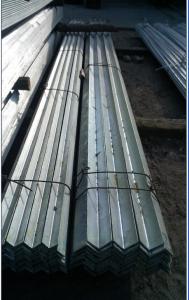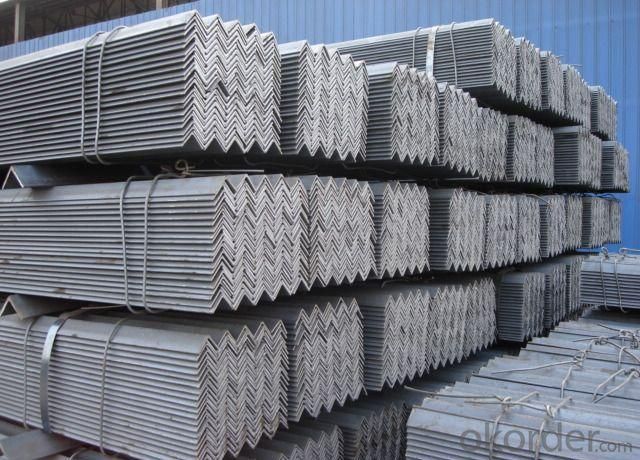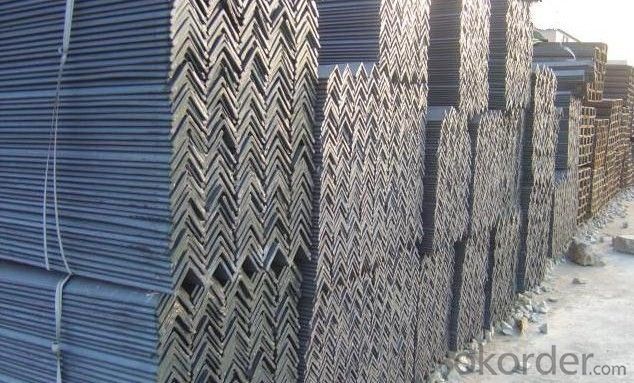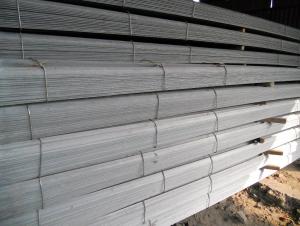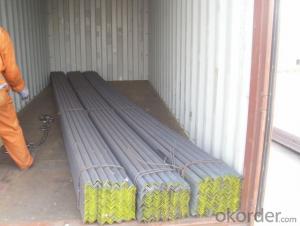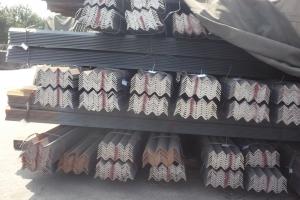GB Q235 Steel Angle
OKorder Service Pledge
OKorder Financial Service
You Might Also Like
Specifications of Equal Angle Steel
1.Standards:GB
2.Length:6m,9m,12m
3.Material:GBQ235,Q345 or Equivalent
4. Size: 50*50mm, 60*60mm, 63*63mm
Usage & Applications of Equal Anlge Steel
Trusses;
Transmission towers;
Telecommunication towers;
Bracing for general structures;
Stiffeners in structural use.
Packaging & Delivery of Equal Angle Steel
1. Transportation: the goods are delivered by truck from mill to loading port, the maximum quantity can be loaded is around 40MTs by each truck. If the order quantity cannot reach the full truck loaded, the transportation cost per ton will be little higher than full load.
2. With bundles and load in 20 feet/40 feet container, or by bulk cargo, also we could do as customer's request.
3. Marks:
Color mark: There will be color marking on both end of the bundle for the cargo delivered by bulk vessel. That makes it easily to distinguish at the destination port.
Tag mark: There will be tag mark tied up on the bundles. The information usually including supplier logo and name, product name, made in China, shipping marks and other information request by the customer.
If loading by container the marking is not needed, but we will prepare it as customer request.
*If you would like to get our price, please inform us the size, standard/material and quantity. Thank you very much for your attention.
- Q: How do you measure the dimensions of a steel angle?
- To measure the dimensions of a steel angle, you would typically use a combination of tools such as a measuring tape or ruler, a protractor, and a square. First, you would measure the length of one side of the angle using a measuring tape or ruler. Place the tape or ruler along the side of the angle and note the measurement. Next, you would measure the length of the other side of the angle in the same manner. Make sure to measure from the same starting point as the first side to ensure accuracy. To measure the angle itself, use a protractor. Align the base of the protractor with one side of the angle and ensure that the other side is aligned with the correct degree marking on the protractor. Read the measurement on the protractor to determine the angle of the steel angle. Lastly, you can use a square to check if the angle is truly 90 degrees. Place the square against the two sides of the angle and ensure that it aligns perfectly with both sides. If it does, then the angle is indeed 90 degrees. It is important to note that these measurements may be approximate and may vary slightly due to manufacturing tolerances.
- Q: How do steel angles contribute to the overall lateral stability of a structure?
- Steel angles contribute to the overall lateral stability of a structure in several ways. Firstly, they can be used as bracing members to resist lateral forces such as wind or seismic loads. By connecting the angles to the main structural elements of the building, they help to distribute these forces and prevent the structure from collapsing or deforming under the applied load. Additionally, steel angles can be utilized as stiffeners to enhance the stiffness and rigidity of key structural components. By adding angles to beams, columns, or other elements, their resistance to bending or buckling is increased, thereby improving the overall lateral stability of the structure. Moreover, steel angles can act as shear connectors between different structural elements. By welding or bolting angles to beams, for example, they create a connection that enables the transfer of shear forces between the components. This is crucial for ensuring that the structure remains stable and can withstand lateral loads without significant deformation or failure. Furthermore, steel angles can be employed as diagonal members in truss systems. By forming diagonal bracing, they help to distribute the applied loads more evenly across the structure, preventing excessive lateral displacements and maintaining the overall stability of the building. Overall, steel angles play a vital role in enhancing the lateral stability of a structure. Their use as bracing members, stiffeners, shear connectors, and diagonal members all contribute to distributing and resisting lateral forces, ensuring that the structure remains stable and capable of withstanding external loads.
- Q: What is the angle iron back machine?
- The process of removing the right angle of the angle steel is to shovel back, also called shovel edge. The traditional machining and low production efficiency, high labor intensity, the company through a large number of technological innovation, design and manufacture of efficient continuous feeding (limited length) of the TGC200 series CNC shoveling machine, can fully meet the demand of processing in shoveling tower.
- Q: What is the typical yield strength of steel angles?
- The typical yield strength of steel angles can vary depending on the specific grade and composition of the steel. However, for commonly used structural steel angles, the yield strength is typically around 36,000 to 50,000 psi (pounds per square inch). This yield strength represents the amount of stress or load that the steel angle can withstand before it starts to deform permanently. It is important to note that different steel grades and sizes may have different yield strengths, so it is always recommended to consult the manufacturer or relevant standards for accurate and specific information regarding the yield strength of steel angles.
- Q: How are steel angles different from steel channels?
- Structural steel shapes commonly used in construction and engineering projects include steel angles and steel channels. These shapes differ in both their form and structural characteristics. Steel angles possess an L-shaped cross-section, featuring two legs positioned at right angles to one another. The length of these legs can be equal or unequal, depending on the specific application. Steel angles are frequently employed to provide structural support in various scenarios, such as framing, bracing, and reinforcement. They play a vital role in construction projects, enhancing stability and strength. Conversely, steel channels possess a U-shaped cross-section, with two parallel flanges connected by a web. The flanges are oriented in the same direction, while the web serves as a connecting element. Steel channels are commonly utilized in load-bearing applications, including building frameworks, support beams, and infrastructure projects. These channels are designed to distribute weight evenly and ensure structural stability. Regarding their structural properties, steel angles are renowned for their high strength-to-weight ratio. This characteristic makes them suitable for applications requiring strength and durability. Steel angles can be easily welded, bolted, or riveted, contributing to their versatility and ease of handling. On the other hand, steel channels excel in load-bearing capabilities due to their U-shaped design. The parallel flanges enhance strength and stability, making them ideal for supporting heavy loads and resisting bending or twisting forces. Steel channels are also recognized for their resistance to warping and twisting, ensuring the integrity of the structure. In conclusion, steel angles and steel channels differ in terms of form and structural characteristics. Steel angles possess an L-shaped cross-section and are commonly used in framing and reinforcement, while steel channels possess a U-shaped cross-section and are employed in load-bearing applications. Understanding these disparities is crucial when selecting the appropriate structural steel shape for a construction or engineering project.
- Q: How do you determine the load-bearing capacity of a steel angle?
- To determine the load-bearing capacity of a steel angle, several factors need to be considered. Firstly, the material properties of the steel angle must be known, such as its yield strength and ultimate tensile strength. These values can be obtained from the manufacturer or from relevant material standards. Next, the dimensions and shape of the steel angle play a crucial role in determining its load-bearing capacity. The angle's thickness, width, and length should be measured accurately. Additionally, the angle's shape, whether it is equal or unequal, must also be taken into account. Once these properties are known, the load-bearing capacity can be calculated using engineering principles and structural analysis methods. One common approach is to use the Euler's formula, which considers the bending and axial loads on the steel angle. The Euler's formula states that the load-bearing capacity of a steel angle is proportional to its moment of inertia and the modulus of elasticity. These values are calculated based on the dimensions and shape of the angle. Furthermore, other factors such as the angle's end supports, the type of loading (e.g., concentrated load or uniformly distributed load), and any additional factors of safety must be taken into consideration. It is important to note that determining the load-bearing capacity of a steel angle is a complex process that requires expertise in structural engineering. Therefore, it is recommended to consult with a qualified engineer or refer to relevant design codes and standards to ensure accurate and safe calculations.
- Q: How do you calculate the axial load capacity of a steel angle?
- In order to determine the axial load capacity of a steel angle, several factors must be taken into consideration. These factors include the material properties of the angle, its dimensions, the type of loading, and the safety factor. Initially, it is necessary to establish the yield strength of the steel angle. This value represents the maximum stress that the angle can endure without experiencing permanent deformation. The yield strength can be obtained either from the specifications of the steel angle or through material testing. Following this, the dimensions of the angle, including its length, thickness, and width, need to be measured. These measurements are crucial in determining the cross-sectional area of the angle. Once the yield strength and cross-sectional area have been determined, the axial load capacity can be calculated using the formula: Axial load capacity = Yield strength × Cross-sectional area It is important to note that this formula assumes that the angle is subjected to direct axial loading. If the angle is exposed to combined loading or other complex loading conditions, additional calculations or structural analysis may be necessary. Furthermore, it is customary to apply a safety factor to the calculated axial load capacity in order to account for uncertainties and ensure structural integrity. The determination of the safety factor is typically based on the specific application and industry standards. For instance, a safety factor of 1.5 is commonly utilized in structural design. To summarize, the calculation of the axial load capacity of a steel angle requires knowledge of its yield strength, measurement of its dimensions, and the application of the appropriate safety factor. This calculation provides an estimation of the maximum load the angle can withstand without failure under axial loading conditions.
- Q: What are the properties of steel angles?
- Steel angles, also known as angle iron or L-shaped steel, possess several properties that make them highly versatile and widely used in various industries. 1. Strength and durability: Steel angles are made from solid steel and are known for their exceptional strength and durability. These properties make them suitable for structural applications where high strength is required, such as in building frames and supports. 2. Load-bearing capacity: Due to their L-shaped design, steel angles offer excellent load-bearing capacity. They can efficiently distribute weight and provide structural support, making them ideal for constructing bridges, towers, and other heavy-duty structures. 3. Versatility in applications: Steel angles can be used in a wide range of applications due to their flexibility and adaptability. They can be easily cut, drilled, and welded, allowing for customization to fit specific project requirements. Steel angles are commonly used in the construction, manufacturing, and automotive industries. 4. Corrosion resistance: Steel angles can be manufactured with corrosion-resistant coatings or made from stainless steel, providing protection against rust and other environmental factors. This corrosion resistance makes them suitable for outdoor applications and in environments with high moisture or chemical exposure. 5. Cost-effectiveness: Steel angles are cost-effective compared to other structural materials, such as aluminum or wood. They offer a high strength-to-weight ratio, minimizing the amount of material required for a given application. This makes steel angles a cost-efficient choice for various construction projects. 6. Aesthetics: Steel angles can also be used for their aesthetic appeal, adding a visually appealing dimension to architectural designs. They can be utilized for decorative purposes in interior design or as part of ornamental structures, providing both functionality and visual interest. Overall, the properties of steel angles, including strength, load-bearing capacity, versatility, corrosion resistance, cost-effectiveness, and aesthetic appeal, make them an excellent choice for a wide range of applications in different industries.
- Q: Can steel angles be used in curtain wall systems?
- Yes, steel angles can be used in curtain wall systems. They are commonly used as support elements for attaching glass panels or other cladding materials to the structural frame of the building. Steel angles provide strength and stability to the overall curtain wall system.
- Q: Can steel angles be used for conveyor systems?
- Yes, steel angles can be used for conveyor systems. Steel angles are often used as structural supports in conveyor systems due to their strength and durability. They can be used to create frames, supports, and guides for the conveyor belts, ensuring stability and proper functioning of the system.
Send your message to us
GB Q235 Steel Angle
OKorder Service Pledge
OKorder Financial Service
Similar products
Hot products
Hot Searches
Related keywords
